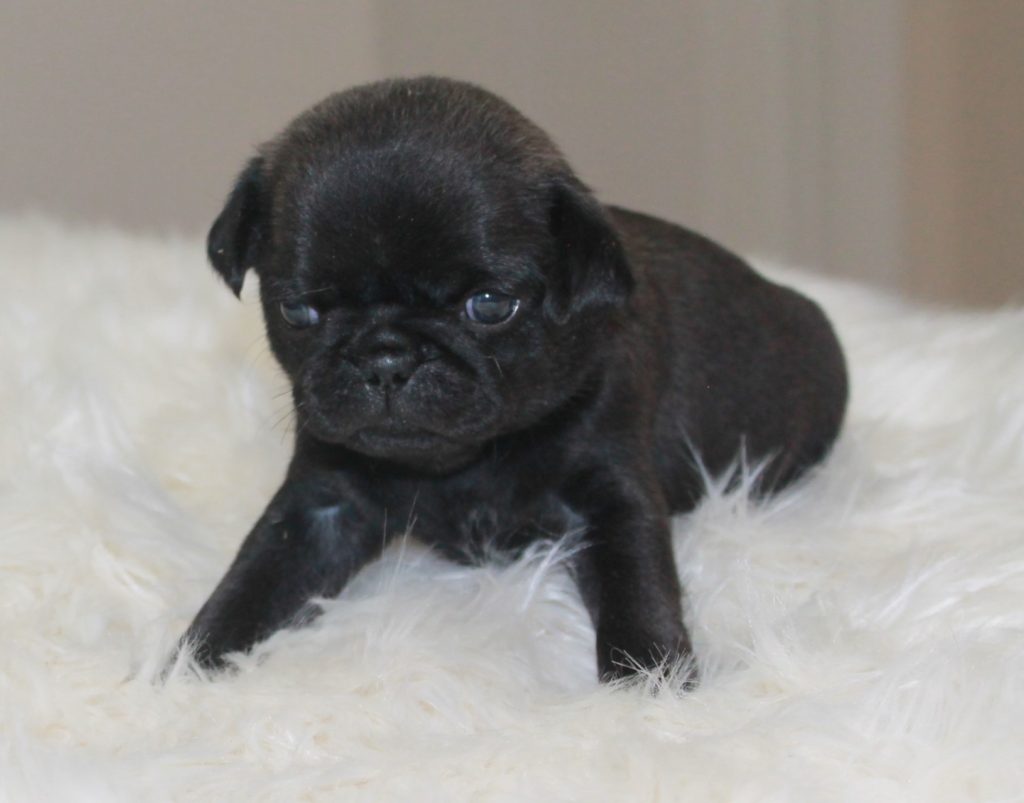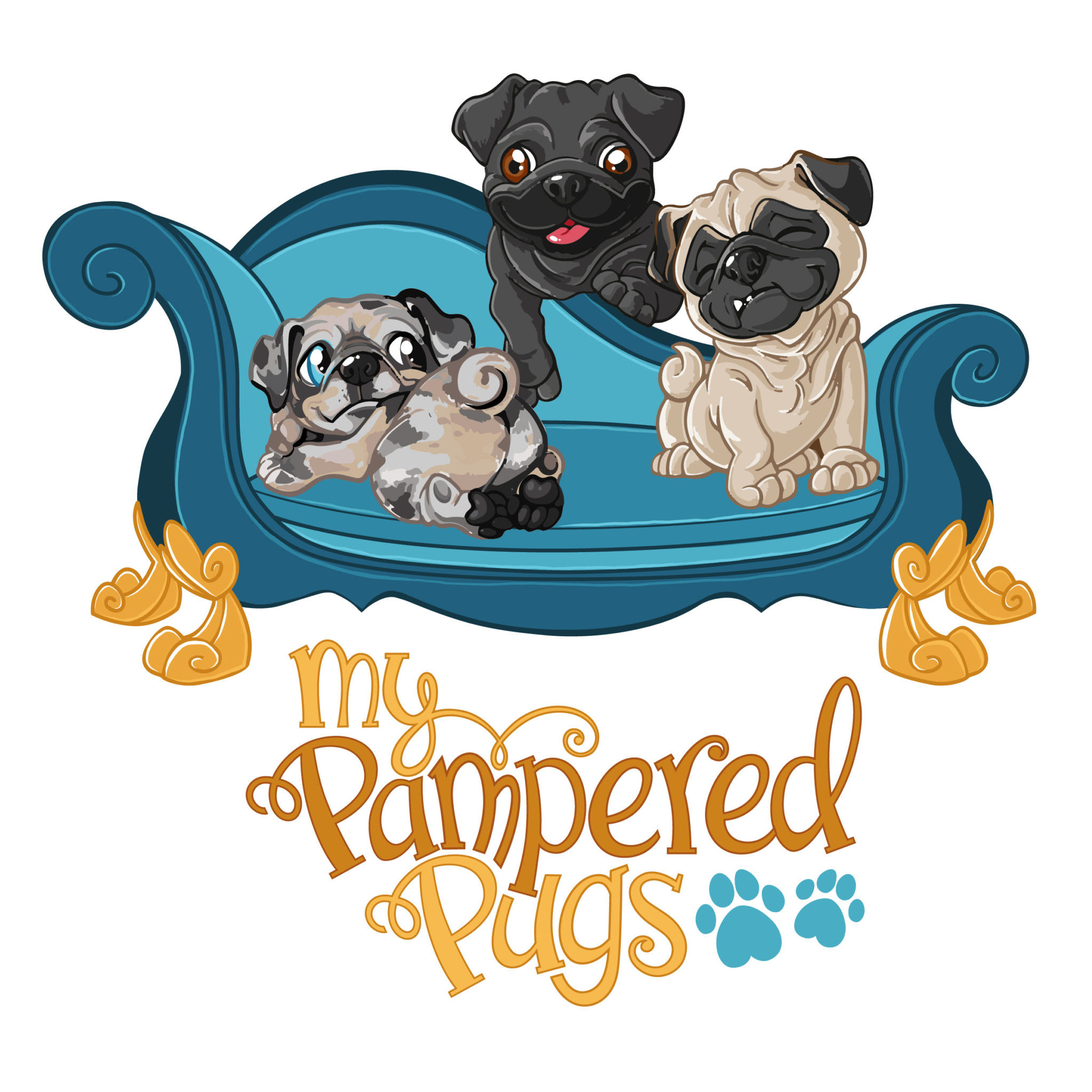Written By Tina Hinze
Thank you for reading this post, don't forget to subscribe!Bringing a new fur baby into your family’s life can be exciting and challenging. Here are recommendations for help looking after your puppy from eight weeks to 18 months. The details will help you give your puppy the best start in life and avoid problems later on.

Up to 8 weeks – before you bring your puppy home
My Pampered Pugs as a professional breeder has completed the following:
- Organizing their first puppy vaccination
- Starting puppy pad training
- Starting socializing them by introducing them to new situations and people
Our pet owners, we recommend you complete the following before bringing your fur baby home and prepare for your new puppy’s arrival:
- Puppy-proof your home by proofing the house involves removing small items from the floor, placing cords out of reach or wrapping them in cord protectors, finding new places for shoes and other objects that may be chewed, and placing child-proof locks on any lower cabinets that a Pug may be able to access.
- Creating a unique space for your fur baby and buying toys: you’ll need space for your puppy to play and toys to keep them occupied.
- Provide somewhere for them to rest: a crate, hiding places, and a cozy bed in a quiet, draught-free place where your puppy can rest undisturbed. We highly recommend crate training.
- Using the blanket from the puppy’s first home – bring this back with you so they have something familiar and comfortable to snuggle in.
- Remove anything poisonous or that you don’t want them chewing. Please see my blog on common toxic plants that can keep your furbaby safe. https://mypamperedpugs.com/keep-your-fur-babies-safe/
- Find a local veterinarian and schedule your first appointment within a week of getting your puppy. Use this link to locate a local vet in your area. https://www.pawlicy.com/vets-near-me/
- Sign up for puppy training classes. American Kennel Club has excellent resources and references for training classes. Please visit their website at https://www.akc.org/expert-advice/training/basic-obedience-training-for-your-dog/
- Register your puppy and get pet insurance. Registering your puppy with AKC or CKC, the first month of pet insurance is usually free.






8-16 weeks – bringing your puppy home
Homecoming is an important time for your puppy because your puppy will learn, and experience will shape their behavior. Your puppy isn’t fully vaccinated yet, but it’s essential to continue socialization by giving your puppy positive experiences like:
- Introducing them to other pets – let them meet other healthy, fully vaccinated dogs and cats.
- Carry your puppy around your home and new environment, introducing them to new people, sights, and sounds.
- Gradually introduce the puppy to other experiences, such as the car, grooming, handling, and checking their ears, eyes, and other body parts.
- Begin to leave them alone for short periods to prevent separation-related behavior.
- Establish a consistent routine and rules – reward and ignore bad behavior.
- Feed them the same puppy food as before and keep the same routine with small, regular meals.
- Continue puppy pad training by rewarding them when they use the pad.
- Perform grooming on time. Pugs are prone to skin yeast infections and eye issues and are heavy shedders, so this breed requires lots of grooming. It is best to stick to a schedule regarding these care tasks. Below are recommended hygiene maintenance for your Pug:
- Baths – We bathe our pugs once a month, even if your puppy or dog does not appear to be dirty. Bathing help prevents foul odors, moisturizes skin, and loosens dead hairs from the coat. You can bathe pugs in the kitchen sink or the bathtub. Because the Pug has sensitive skin, use a shampoo with a pH between 6.5 and 7.5 and does not contain any soaping agents, parabens, pthalates, sulfates, chemical preservatives, or artificial colors, and surfactants like cocamide-MEA. Please see my blog on my favorite items made in the USA on the grooming products on my pugs. https://mypamperedpugs.com/my-fav-amazon-dog-products/
- Eye maintenance – Pug’s eyes are large and bulging, which means they are prone to picking up debris that can irritate the eyes or scratch the cornea. Tiny food particles are a top culprit. Keep the eye area clean by wiping it at least once a day and as often as after each meal. For this, you can use the same type of wipe you have for your Pug’s wrinkles (see next tip).
- Wrinkle maintenance – Pugs have many deep wrinkles on their head and face, which makes these areas prone to skin infection, so attention must be given to keeping these folds clean and dry. Wipe the wrinkles at least once a day or week, depending on the Pug.
- Brushing – Pugs are heavy shedders. Many dead hairs stay lodged in the coat, and some fall to the floor. So, even if you do not notice much shedding, brushing your Pug regularly is essential. Recommended to brush puppies once a week and adults Pugs every other day and as often as once per day.
16 weeks onwards – puppy training and socialization
Your puppy can have their final vaccinations, and while you’re at the vet, ask them about worming flea treatment and neutering.
- Once fully vaccinated, socialize your pup outside and in public locations like dog parks and stores like Lowe’s, Home Depot, Petco, Petsmart, and other retailers that allow dogs. Ensure to use a harness and not a collar. Pugs are a brachycephalic breed that is very prone to breathing issues. Just about every purebred Pug has some level of stenotic nares (narrowed nostrils), which can make breathing difficult, and an elongated palate (the soft tissue at the back of the roof of the mouth partially blocks the windpipe). Using a collar when on a leash, which places pressure on the trachea, is near guaranteed to exacerbate this.
- So, part of caring for a Pug involves using accessories that do not impede breathing. For this reason, a harness should be used whenever a Pug is on a leash. Harnesses displace tension over the shoulders, back, and chest, freeing the neck.
- Take them to puppy classes – suitable puppy classes are a great way to boost their confidence and learn basic training.
- Understand what they like – knowing what your puppy wants (such as their favorite food or toys) can motivate them during training.
- Let them rest regularly – growing and learning are tiring, so let them rest periodically and keep training sessions short and fun. If your puppy is crate trained, let them use it as a haven.

Six– 18 Months
Puppies are still learning at this age, so continue reward-based training and keep all experiences positive.
Remember:
- Speak to your vet if you have any concerns about your puppy, and ask them about spaying or neutering. Males and female pugs can be spayed or neutered between 6 – 9 months.
- Spay and Beuter benefits include:
- Your female pet will live a longer, healthier life. Spaying helps prevent uterine infections and breast cancer, which is fatal in about 50 percent of dogs -spaying your pet before her first heat offers the best protection from these diseases.
- Neutering provides significant health benefits for your male. Besides preventing unwanted litter, neutering your male companion prevents testicular cancer if done before six months of age.Your spayed female won’t go into heat. While cycles can vary, female pugs can go into heat early and frequently.Your male dog won’t want to roam away from home. An intact male will do just about anything to find a mate! That includes digging his way under the fence and possibly getting hit by a car.Your neutered male will be much better behaved. It is highly cost-effective. Your pet’s spay/neuter surgery costs a lot less than the cost of having and caring for a litter. It also beats the cost of treatment when your unneutered male fights with another male dog, possibly a giant or aggressive dog.
- Spaying and neutering your pet is good for the community.
- Keep your Pug on a healthy diet. What you choose to feed your Pug will have short- and long-term consequences, affecting everything from weight maintenance to allergies to intestinal health. Pugs do better with dry kibble than wet canned food; a dry formula keeps stools firm and is better for the teeth. Puppies should be fed 2 to 3 times daily, which can transition to twice daily at six months. Several dry snacks can be given between meals, and moist treats can be given to reward good behavior, such as house training and obeying commands.
- This breed generally has a very hearty appetite, and their intolerance for extended exercise makes it easy to gain excess weight. Pugs also tend to have sensitive stomachs and are prone to skin reactions from food additives. Therefore, aim to provide all-natural foods with no chemical preservatives, artificial flavoring, or dyes, and no by-products, high grain counts, generic meats or oils, corn, soy, or other cheap product fillers.
- Follow exercise requirements and restrictions. Despite their reputation for being lazy, Pugs can have a good amount of energy. And you’ll want to meet this by keeping your Pug moving along for several reasons:
- Exercise plays an essential role in a Pug’s physical health. It is good for the heart and lungs, regulates metabolism, helps maintain proper muscle composition, boosts the immune system, and can keep certain diseases at bay, including canine diabetes and some forms of cancer. Exercise also plays a vital role in a dog’s mental health; it allows it to release any restlessness that bottles up and provides for desensitization and socialization to all outside elements. At the same time, too much exertion in either duration or intensity can lead to breathing difficulties or overheating for this brachycephalic breed. So, the goal for this caring element is to exercise your Pug regularly while keeping in mind your dog’s limitations.
- Pugs do best, with at least two walks per day. Each session should last at least 20 minutes but can extend to 45 or longer if your Pug has the energy. Breaks should be taken at the halfway mark of a short walk, every 15 to 20 minutes for a longer walk, or any time a Pug is breathing noticeably heavier than usual. Bring your Pug into the shade and offer fresh water, ensuring that breathing is back to normal before starting up again.
- Light to moderate cardio sessions can also be added in, with a rousing game of fetch being the easiest to play and one that most dogs love.
- Move to more advanced dog training classes if your puppy is ready to progress.
- Move them onto adult dog food as they get bigger and their dietary needs change.
- Keeping experiences positive from day one will help your puppy grow into a confident adult dog, making life more enjoyable for you both.







